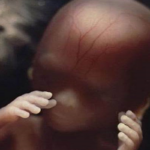Blog Post
The Gosnell film prosecutes the entire abortion industry
By Jonathon Van Maren
Five years ago, I sat in a courtroom in Philadelphia, watching the prosecutor make his final pitch to the jury. Kermit Gosnell, the abortionist on trial, was seated at the front, his face split with a permanently creepy smile. He seemed pleased that he had perfected the practice of “snipping”: Delivering babies, flipping them over, and then plunging a pair of scissors into the backs of their necks to sever their spinal cords. Hundreds of babies died like that at the hands of Gosnell and his staff; perhaps even more. Displays were set up for the packed courtroom to see: the blood-spattered operating chair and stirrups and photos of babies with bloody holes in the backs of their necks among them.
Gosnell: The Trial of America’s Biggest Serial Killer is part documentary, part crime drama, and part legal thriller, with a screenplay written by the Daily Wire’s Andrew Klavan and based on the book Gosnell: The Untold Story of America’s Most Prolific Serial Killer by Irish journalists Phelim McAleer and Ann McElhinney. (McElhinney joined me on my podcast to discuss the book last year.) I found it to be a well-made docu-drama, although not as gut-wrenching as it could have been due to the creative decision to hide much of the true brutality of what went on in Gosnell’s clinic—the severed baby’s feet in jars in a refrigerator and the tops of the heads of dead infants are as close as this film gets to the reality of the crimes of Kermit and his cutthroats.
What Gosnell does brilliantly is highlight the fact that there is very little difference between feticide and post-birth abortion. In fact, Gosnell’s defence lawyer Jack McMahon went out of the way to present his client as a regular work-a-day abortionist who was just a bit more creative with his killing and a bit less rigid in his interpretation of the law. The first-hand testimonies—taken nearly word for word from the court transcripts—highlight the naked brutality of the abortion procedure, as well-dressed women describe “emptying the skulls” of the babies being extracted from the womb, and detail the dismemberment process with nauseating specificity. In order to defend Gosnell, his lawyer essentially prosecutes the entire abortion industry. It is rivetingly effective stuff.
It is no surprise that Gosnell is facing obstacles across the United States. Fundamentally, the film is an indictment of the entire pro-choice establishment: The refusal of state authorities to inspect Gosnell’s clinic, thus permitting his barbarism to continue; the initial refusal of the media to cover the trial; the reluctance of many to go after Gosnell due to the fact that his case might reflect badly on abortion rights. It is not only possible but likely that infants were murdered in Gosnell’s clinic because state authorities refused to investigate the filthy, feces-flecked, cat-infested house of horrors. Earl Billings, the actor who portrays Kermit Gosnell, perfected Gosnell’s sociopathic smile with chilling accuracy—I remember the murderer turning and at beaming at the pro-lifers in the courtroom vividly.
Gosnell is a film about abortion and the power of the truth to change everything. It was photos of Gosnell’s tiny victims—the film shows the jury’s reaction to a photo of Baby A, but declines to actually show the photo itself—that changed the minds of the filmmakers on abortion in the first place. The docu-drama’s most powerful scene comes when one of the prosecutors asks the nurse who photographed Baby A a question: “Why did you decide to take a picture of this particular baby?”
“He was so big,” the nurse responded. “He looked like he could be somebody’s little brother. I just thought there should be a picture of him. To show the world that he was here for a little while.”
Baby A and 65 million other children were here for just a little while before their lives were abruptly truncated with a savagery that Gosnell powerfully showcases with dry cross-examination exchanges between McMahon and the pleasant abortionists on the stand. Gosnell may be about the trial of a single abortionist, but the filmmakers prosecute the abortion industry itself. For abortion activists, that makes Gosnell an incredibly dangerous film.








